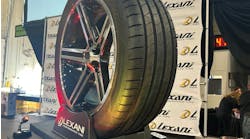Canada Tire Inc. had a big customer list when Gabriel Granatstein became the company's CEO several years ago.
However, not long after his arrival, Granatstein discovered that only some of those accounts were being contacted by Canada Tire’s sales reps on a regular basis.
“On paper, we had a lot of customers, but in practice, only a small percentage were buying regularly from us,” he says.
“What I saw very quickly is that even if a sales rep had 200 customers, the same 10 names were always popping up in their reports. Our team focused only on the big accounts.
“We were too concentrated,” which he says “was a bit scary. We didn’t have a systemized way of ensuring we were calling on all customers regularly. And we didn’t have any way of ensuring customer requests were being followed up on.”
A change was needed.
Granatstein introduced a customer relationship management (CRM) tool, “which was a new concept for our business.”
Once implemented, the CRM allowed Canada Tire sales reps to run reports on how many clients contacted — and ordered from — the company “in a given week or month.
“More than that, it was a form of a trojan horse that allowed us to collect data, see trends and ensure we were servicing our customers properly.”
Within a year, Canada Tire’s sales increased significantly. “I see more opportunities for growth in our future.”
Diverse customer base
Canada Tire — which was founded nearly 100 years ago by Granatstein’s great-grandfather, Louis Wiseman — has one large distribution center in Mississauga, Ontario, which is near Toronto.
It also has three warehouses in Quebec — in Valleyfield, Sherbrooke and Levis — and three distribution centers in the Maritimes.
The company’s footprint “allows us to serve the vast majority of urban centers in eastern Canada,” according to Granatstein.
Canada Tire’s warehouses in Valleyfield and Mississauga are the company’s “core centers.” Both hold 100,000 to 150,000 tires at any given time.
The other distribution centers stock anywhere from 20,000 to 40,000 units each.
“In terms of transport, we like to work with local carriers or companies that we know will offer above-and-beyond service.
“This does create a situation where each distribution center has a slightly different make-up for delivery,” but the end goal remains “providing the best service possible.”
Independent tire dealers make up the bulk of Canada Tire’s clientele. “Typically, these customers have revenues in the $300,000 to $3 million-a-year range.
“We also have a strong mix of car rental companies and fleet accounts that provide us with diversity.”
That includes big companies like Avis, Budget and Enterprise.
“There are hubs and service centers that car rental companies have, where they store vehicles,” says Chris Moody, Canada Tire’s director of sales.
Successfully serving car rental companies means “making sure they have proper tire inventory” in those places “and also making sure we have the ability to get tires” to individual vehicle rental outlets, including ones at airports.
Service trumps price when supplying tires to car rental companies.
“The most important thing is reducing their downtime,” says Moody. “The faster we can ship tires, the less downtime they have.”
Canada Tire also ships tires to ride share services — “in a lot of cases, through third parties, some of which offer mobile tire installation,” adds Moody.
Granatstein says Canada Tire’s product mix has evolved over the years.
“At tier one, we only sell Pirelli. In the second tier, we sell Falken, Nexen and Cooper. We pick brands our competitors don’t sell.
“Our customers like selling these hidden gems that are more profitable for them and save their customers money.”
Canada Tire also owns and sells three brands that are exclusive to the company — Minerva, Ovation and Maxtrek — which are manufactured in China and are marketed as entry-level lines.
“We put a 30-day trial and road hazard warranty on everything we sell, including those tires.”
Like other tire distributors, the company has seen customers gravitate toward less-expensive products.
“Given the choice of paying $2,000 for a set of tier-one tires or $1,500 for a set of tier-two tires, they’re going to pay $1,000 or less for a third-tier set,” says Granatstein.
Selective strategy
“Part of our strategy is to not carry every tire brand under the sun,” notes Granatstein, which he says Canada Tire’s dealer customers appreciate.
“They are looking for — and want — simplicity. When you have rapidly accelerating technology and product releases and an explosion of sizes and dimensions on new vehicles, we find that decision-makers at our customers are more conservative with carrying inventory.
“They just can’t predict what will roll into their shop and what, specifically, that vehicle will need. This creates pressure on us to ensure that we’re doing the proper analysis and have the right products available to them at the right time.
“We’ve had to create new tools to ensure we use all the data available to us (and are) as efficient as possible and (can) effectively predict demand," he says.
“The situation has helped us make a large jump forward in terms of technology, process and sophistication in our purchasing.”
Canada Tire’s marketing has become more targeted, as well.
“When I started, we were spending our marketing dollars going after consumers,” says Granatstein. “I realized that wasn’t an effective spend.
“The guy or girl behind the sales counter really controls the purchase. We now spend our marketing dollars targeting that person. We don’t spend any money marketing our brands to the public.”
‘More professionalized’
Over the years, Canada Tire has become “a more professionalized company,” says Granatstein.
“We’re in our fourth generation now and have grown with the people we have. Everyone was a jack of all trades. But as you grow and your numbers get bigger, you need more expertise.
“As we’ve aged out of certain team demographics, we’ve brought in new people who are more specialized” than their predecessors.
“And in some cases, we’ve focused on retraining existing staff and keeping people focused on their lanes, while keeping everyone aware of what’s going on, so we’re all paddling in the same direction.
“The old saying was, ‘You can only hire people from within the tire industry.” I think Chris (Moody) and I are evidence that people can be trained.”
Before he joined Canada Tire, Granatstein practiced law at a large firm, Norton Rose Fulbright, and before that, was an attorney for mass retailer Target. “I was hired to help launch Target’s business in Canada.”
(He also is a Canadian Army veteran and still serves in the reserves.)
When Granatstein started at Canada Tire, “I learned quickly that no matter how much I learned about tires, I was never going to have as much experience as our customers.
“I also realized that what our customers care about is that the tires we sell are high-quality, that we stand behind our products and that we care about them.”
Recruiting from outside the tire industry also “has allowed us to gain new and diverse perspectives,” adds Moody.
“It has allowed us to be more creative and entertain more interesting ideas. We’re doing things we haven’t really seen before in our competitive set. And we’re excited about that.”
Controlled growth
The Canadian tire industry has seen its share of consolidation in recent years — particularly at the wholesale level.
Two months ago, Distribution Stox, which is headquartered in Quebec, announced its intention to acquire Edmonton, Alberta-based North Country Tire Distributors, which has warehouses in Alberta, British Columbia and Manitoba.
Another quickly growing company is Groupe Touchette, which finalized its purchase of American Tire Distributors Inc.’s (ATD) Canadian subsidiary, National Tire Distributors (NTD), in September 2022.
The combined Groupe Touchette/NTD business is headquartered in Montreal, Quebec, with a main support center in Burlington, Ontario, plus regional offices throughout Canada.
Granatstein sees consolidation as an opportunity instead of a stumbling block.
“We obviously do see the size and strength of the larger players in the landscape that have grown through acquisition,” he says.
“But we also see many healthy, smaller regional wholesalers that are still driving business through relationships and local presence.”
Granatstein doesn’t foresee adding distribution centers or moving into new provinces in the short-term.
“I think we can continue to take market share in Quebec, Ontario and eastern Canada. I’m more interested in expanding in those areas and piggybacking off our existing distribution centers.
“If we thought we’d maximized sales in the provinces we’re already in, then we’d move westward. But we aren’t there yet.
“The most important thing we’re working on is replacing the computer system that governs our entire business, from financial to operational.”
He says the initiative is decidedly “less glamorous” than opening new warehouses.
“The system we have is quite old. Upgrading it will set the stage for us to continue to grow properly and efficiently.
“We’re at the point where we need to change the structural underpinning of our business. It’s like going to the dentist. You have to do it. But it will set the stage for more distribution centers over time.”





